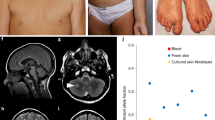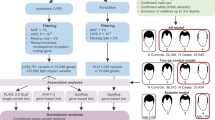Abstract
The genetic determinants of hair texture in humans are largely unknown. Several human syndromes exist in which woolly hair comprises a part of the phenotype; however, simple autosomal recessive inheritance of isolated woolly hair has only rarely been reported1,2. To identify a gene involved in controlling hair texture, we performed genetic linkage analysis in six families of Pakistani origin with autosomal recessive woolly hair (ARWH; OMIM 278150). All six families showed linkage to chromosome 13q14.2–14.3 (Z = 17.97). In all cases, we discovered pathogenic mutations in P2RY5, which encodes a G protein–coupled receptor and is a nested gene residing within intron 17 of the retinoblastoma 1 (RB1) gene. P2RY5 is expressed in both Henle's and Huxley's layers of the inner root sheath of the hair follicle. Our findings indicate that disruption of P2RY5 underlies ARWH and, more broadly, uncover a new gene involved in determining hair texture in humans.
This is a preview of subscription content, access via your institution
Access options
Subscribe to this journal
Receive 12 print issues and online access
$209.00 per year
only $17.42 per issue
Buy this article
- Purchase on Springer Link
- Instant access to full article PDF
Prices may be subject to local taxes which are calculated during checkout




Similar content being viewed by others
Accession codes
References
Salamon, T. Über eine Familie mit recessiver Kraushaarigkeit, Hypotrichose und anderen Anomalien [On a family with the recessive trait of woolly hair, hypotrichosis and other anomalies]. Hautarzt 14, 540–544 (1963).
Hutchinson, P.E., Cairns, R.J. & Wells, R.S. Woolly hair. Clinical and general aspects. Trans. St Johns Hosp. Dermatol. Soc. 60, 160–177 (1974).
Hrdy, D. Quantitative hair form variation in seven populations. Am. J. Phys. Anthropol. 39, 7–17 (1973).
Bernard, B.A. Hair shape of curly hair. J. Am. Acad. Dermatol. 48, S120–S126 (2003).
Thibaut, S. Human hair shape is programmed from the bulb. Br. J. Dermatol. 152, 632–638 (2005).
Stratigos, A.J. & Baden, H.P. Unraveling the molecular mechanisms of hair and nail genodermatoses. Arch. Dermatol. 137, 1465–1471 (2001).
Weeda, G. et al. A mutation in the XPB/ERCC3 DNA repair transcription gene, associated with trichothiodystrophy. Am. J. Hum. Genet. 60, 320–329 (1997).
Vulpe, C., Levinson, B., Whitney, S., Packman, S. & Gitschier, J. Isolation of a candidate gene for Menkes disease and evidence that it encodes a copper-transporting ATPase. Nat. Genet. 3, 7–13 (1993).
Chien, A.J., Valentine, M.C. & Sybert, V.P. Hereditary woolly hair and keratosis pilaris. J. Am. Acad. Dermatol. 54, S35–S39 (2006).
Norgett, E.E. et al. Recessive mutation in desmoplakin disrupts desmoplakin-intermediate filament interactions and causes dilated cardiomyopathy, woolly hair and keratoderma. Hum. Mol. Genet. 9, 2761–2766 (2000).
McKoy, G. et al. Identification of a deletion in plakoglobin in arrhythmogenic right ventricular cardiomyopathy with palmoplantar keratoderma and woolly hair (Naxos disease). Lancet 355, 2119–2124 (2000).
Robben, J.H., Knoers, N.V. & Deen, P.M. Characterization of vasopressin V2 receptor mutants in nephrogenic diabetes insipidus in a polarized cell model. Am. J. Physiol. Renal Physiol. 289, F265–F272 (2005).
Greig, A.V., Linge, C., Terenghi, G., McGrouther, D.A. & Burnstock, G. Purinergic receptors are part of a functional signaling system for proliferation and differentiation of human epidermal keratinocytes. J. Invest. Dermatol. 120, 1007–1015 (2003).
Schweizer, J., Langbein, L., Rogers, M.A. & Winter, H. Hair follicle-specific keratins and their diseases. Exp. Cell Res. 313, 2010–2020 (2007).
Yu, P., Ma, D. & Xu, M. Nested genes in the human genome. Genomics 86, 414–422 (2005).
Levy-Nissenbaum, E. et al. Hypotrichosis simplex of the scalp is associated with nonsense mutations in CDSN encoding corneodesmosin. Nat. Genet. 34, 151–153 (2003).
Goodrich, D.W. & Lee, W.H. Molecular characterization of the retinoblastoma susceptibility gene. Biochim. Biophys. Acta 1155, 43–61 (1993).
Song, H. et al. Common variants in RB1 gene and risk of invasive ovarian cancer. Cancer Res. 66, 10220–10226 (2006).
Lee, S. et al. Forerunner genes contiguous to RB1 contribute to the development of in situ neoplasia. Proc. Natl. Acad. Sci. USA 104, 13732–13737 (2007).
Herzog, H., Darby, K., Hort, Y.J. & Shine, J. Intron 17 of the human retinoblastoma susceptibility gene encodes an actively transcribed G protein-coupled receptor gene. Genome Res. 6, 858–861 (1996).
Webb, T.E., Kaplan, M.G. & Barnard, E.A. Identification of 6H1 as a P2Y purinoceptor: P2Y5. Biochem. Biophys. Res. Commun. 219, 105–110 (1996).
Li, Q., Schachter, J.B., Harden, T.K. & Nicholas, R.A. The 6H1 orphan receptor, claimed to be the p2y5 receptor, does not mediate nucleotide-promoted second messenger responses. Biochem. Biophys. Res. Commun. 236, 455–460 (1997).
Noguchi, K., Ishii, S. & Shimizu, T. Identification of p2y9/GPR23 as a novel G protein-coupled receptor for lysophosphatidic acid, structurally distant from the Edg family. J. Biol. Chem. 278, 25600–25606 (2003).
Kazantseva, A. et al. Human hair growth deficiency is linked to a genetic defect in the phospholipase gene LIPH. Science 314, 982–985 (2006).
Sonoda, H. et al. A novel phosphatidic acid-selective phospholipase A1 that produces lysophosphatidic acid. J. Biol. Chem. 277, 34254–34263 (2002).
Acknowledgements
We are grateful to the family members for their participation in this study, and to H. Lam and M. Zhang for technical assistance. We appreciate the collaboration and discussions with R.M. Bernstein, H. Bazzi, V. Luria and K. Fantauzzo. We thank L. Langbein and J. Schweizer (Heidelberg) for generously sharing antibodies. We thank S. Ishii for discussions about P2RY5. This work was supported in part by US Public Health Service National Institutes of Health grant R01AR44924 from the National Institute of Arthritis and Musculoskeletal and Skin Diseases (to A.M.C.).
Author information
Authors and Affiliations
Contributions
The study was designed and supervised by A.M.C. Laboratory work and phenotyping and pedigree ascertainment were performed by Y.S., Y.I. and M.W.; statistical analyses were performed by L.P. and D.G.; clinical observations were made by M.W., Y.S. and A.M.C.; molecular modeling of P2RY5 mutations was performed by L.S.; and Y.S., L.P. and A.M.C. contributed to the preparation of the manuscript.
Corresponding author
Supplementary information
Supplementary Text and Figures
Supplementary Figures 1–5, Supplementary Table 1, Supplementary Note, Supplementary Methods (PDF 2063 kb)
Rights and permissions
About this article
Cite this article
Shimomura, Y., Wajid, M., Ishii, Y. et al. Disruption of P2RY5, an orphan G protein–coupled receptor, underlies autosomal recessive woolly hair. Nat Genet 40, 335–339 (2008). https://doi.org/10.1038/ng.100
Received:
Accepted:
Published:
Issue Date:
DOI: https://doi.org/10.1038/ng.100
This article is cited by
-
Alopezien und Hypotrichosen im Kindesalter: Wann muss an genetische Diagnostik gedacht werden?
Monatsschrift Kinderheilkunde (2021)
-
Lysophosphatidic Acid Receptor 6 (LPAR6) Expression and Prospective Signaling Pathway Analysis in Breast Cancer
Molecular Diagnosis & Therapy (2019)
-
Genetic Hair Disorders: A Review
Dermatology and Therapy (2019)
-
Structural insights into ligand recognition by the lysophosphatidic acid receptor LPA6
Nature (2017)
-
A novel homozygous variant in the dsp gene underlies the first case of non-syndromic form of alopecia
Archives of Dermatological Research (2015)



